Aug. 4, 2021
Dear Friends:
For several years now, our patient manager, Philip Roberts, has been telling me he feels like Radar O’Reilly on M*A*S*H. Fans of the dark Korean War comedy will recall that often after endless hours of stitching up battlefield casualties—and having just flopped onto their cots—the doctors would be interrupted by Radar announcing, “Incoming choppers.”
 So indeed it goes here at the foundation. Hardly a week passes when we don’t perform virtual triage on desperate PFS patients from various continents. And on their wives. And their girlfriends. And mothers and fathers and sisters and brothers and best friends and boyfriends and just when we think finasteride has done all the damage it can do for that week, in staggers another case of PFS.
So indeed it goes here at the foundation. Hardly a week passes when we don’t perform virtual triage on desperate PFS patients from various continents. And on their wives. And their girlfriends. And mothers and fathers and sisters and brothers and best friends and boyfriends and just when we think finasteride has done all the damage it can do for that week, in staggers another case of PFS.
After nearly a decade of this madness, much as we hate to admit, we occasionally lose heart. We wish that the frightening array of persistent side effects stemming from finasteride use in a subset of patients would just go away after quitting, just like Merck & Co. indicates. Because we don’t know how much fight we have left.
But then something happens to keep us from flopping back onto our cots: We win a battle.
Researchers publish a study that confirms what tens of thousands of PFS patients have been telling their doctors for years. A media report uncovers more truths about how finasteride came to be approved, and the extent to which it’s decimating families. A respected MD issues an ALL-CAPS TWEET! urging fellow MDs to stop prescribing finasteride. A patient considering taking finasteride tells us that, after reading our website, he decided never to go near the drug.
The good news is, such battle victories are becoming more common. And while we can’t promise we’ll win the war, you have our word that we’ll keep fighting. Like hell.
Now, to mark our ninth anniversary, I’d like to share some highlights from the past 12 months.
RESEARCH
 The first Holy Grail of PFS research is proof on the molecular level that the condition exists. The second, no doubt, is a formula for some effective therapy. While such a therapy may be years off, we’re now more hopeful than ever that it can be achieved due to numerous paths being paved.
The first Holy Grail of PFS research is proof on the molecular level that the condition exists. The second, no doubt, is a formula for some effective therapy. While such a therapy may be years off, we’re now more hopeful than ever that it can be achieved due to numerous paths being paved.
In the first study to consider and demonstrate gene expression differences as a potential etiology of the sexual dysfunction experienced by PFS patients, researchers made a startling discovery: the PFS patients had 1,446 significantly over-expressed (upregulated) and 2,318 significantly under-expressed (downregulated) genes as compared to controls. Those differentially expressed genes in penile skin tissue of PFS patients identify biological pathways that may be relevant in the development of PFS symptoms.
Titled Differential Gene Expression in Post-Finasteride Syndrome Patients, the study was published last month in The Journal of Sexual Medicine. Mohit Khera, MD, Director of the Laboratory for Andrology Research at Baylor College of Medicine, led a team of three researchers from two additional institutions: University of Texas McGovern Medical School and University of Utah School of Medicine.
Among their key findings:
- Androgen receptor (AR) expression was significantly higher in study subjects compared to controls (P value = 0.01). “Over-expression of AR in penile tissue may be responsible for sexual symptoms experienced by PFS patients… The fact that AR expression was elevated in PFS patients suggests a chronic androgen-deficient, or activity-deficient, state.”
- 15 over-expressed and 12 under-expressed genes involved in AR signaling were also identified. “Given that gene expression has been implicated in numerous disease states, AR overexpression in response to an androgen-deficient state may negatively affect multiple tissues throughout the body.”
- Immune system pathways related to T-cell development and cytokine signaling were also upregulated.
- “The under-expression of…‘protective genes’ [in PFS patients] in the context of increased cortisol levels combined with over-expression of inflammatory regulators portrays an emergent picture of chronic stress leading to diverse body systems including the circulatory, skeletal, and nervous systems.”
- Pathways controlling vascular remodeling and development were dysregulated in PFS patients with downregulated pathways more significantly enriched. Dysregulated vascular remodeling and development could likely contribute to poor penile erectile function. Downregulated pathways controlling extracellular matrix function may also be contributing to penile soft tissue abnormalities seen in PFS patients.
In September, Roberto Cosimo Melcangi, PhD, and his team at the University of Milano’s Department of Pharmacological and Biomolecular Sciences published their analysis of fecal microbiota of 23 PFS patients through 16S rRNA gene sequencing. By comparing it with fecal micobiota in ten healthy male cohorts via the same genetic sequencing, the team successfully demonstrated the presence of altered gut microbiota in PFS patients. “There is a growing body of literature showing the relevance of the gut microbiota-brain axis both in human health and disease,” wrote Melcangi in his paper titled Alterations of gut microbiota composition in post-finasteride patients: a pilot study. “[A]lterations in gut microbiota composition have been reported in patients with major depressive disorder” so the fact that it is “altered in PFS patients, suggests it might represent a diagnostic marker and a possible therapeutic target for this syndrome.”
And just seven months after publishing his gut-microbiota study, Melcangi reported that finasteride, a 5α-R inhibitor, also inhibits phenylethanolamine N-methyltransferase (PNMT), an enzyme found primarily in the adrenal gland. That, in turn, may play a role in producing some of the most common PFS side effects. The UniMi team deployed SPILLO-Potential Binding Sites Searcher, a software aimed at identifying alternative off-target protein interactions, for the first time ever in a PFS investigation. “[R]esults revealed a reduction in the levels of epinephrine, with a concomitant increase of norepinephrine levels, coupled to no effect on PNMT protein levels, [suggesting] that the altered hormonal levels were due to a reduction of the enzymatic activity rather than to decreased levels of PNMT,” Melcangi wrote in the study titled Three-Dimensional Proteome-Wide Scale Screening for the 5-Alpha Reductase Inhibitor Finasteride: Identification of a Novel Off-Target. “PNMT activity perturbation may be correlated with sexual and psychological side effects. Therefore, results… suggest that the binding of finasteride to PNMT might have a role in producing the side effects exerted by finasteride treatment.”
On the pharmacovigilance front, two studies, both led by Harvard Medical School researchers, revealed that finasteride patients face far-greater-than-average risks of depression, suicidality and sexual dysfunction than the general population.
 In November, Quoc-Dien Trinh, MD, an Associate Professor of Surgery at HMS, published Investigation of Suicidality and Psychological Adverse Events in Patients Treated with Finasteride, which analyzed suicidality (suicidal ideation, suicide attempt and completed suicide) and psychological adverse events (depression and anxiety) within the World Health Organization’s database of individual safety reports, known as VigiBase. His team found that young men with alopecia taking finasteride had statistically significant safety signals for increased suicidality and psychological adverse events. “This is the first analysis, to our knowledge, of suicidality and psychological adverse events in association with finasteride in VigiBase,” wrote Trinh. “In the context of increased scrutiny of post-finasteride syndrome, our exploratory findings highlight the need to further investigate the adverse events of finasteride use among young patients.”
In November, Quoc-Dien Trinh, MD, an Associate Professor of Surgery at HMS, published Investigation of Suicidality and Psychological Adverse Events in Patients Treated with Finasteride, which analyzed suicidality (suicidal ideation, suicide attempt and completed suicide) and psychological adverse events (depression and anxiety) within the World Health Organization’s database of individual safety reports, known as VigiBase. His team found that young men with alopecia taking finasteride had statistically significant safety signals for increased suicidality and psychological adverse events. “This is the first analysis, to our knowledge, of suicidality and psychological adverse events in association with finasteride in VigiBase,” wrote Trinh. “In the context of increased scrutiny of post-finasteride syndrome, our exploratory findings highlight the need to further investigate the adverse events of finasteride use among young patients.”
In May, Ross J. Baldessarini, MD, at the HMS Department of Psychiatry, published Risk of Depression Associated With Finasteride Treatment, a meta-analysis with a cumulative subject pool of 199,454. The study showed that finasteride use is “significantly associated with clinical depression” and “with strongly suggestive evidence of increased risk of suicidal ideation and suicidal behavior.” Among that team’s findings:
- Crude pooled rates demonstrated a risk of suicidal ideation or behavior that was 51% higher among subjects exposed to finasteride versus those not exposed to the drug.
- Meta-analysis yielded an odds ratio of 2.14 for the risk of clinical depression among subjects exposed to finasteride versus those not exposed to the drug.
- There was a “strikingly elevated risk of sexual dysfunction in male subjects” exposed to finasteride, with more than 60% of them in the cumulative subject pool experiencing this adverse reaction.
(For a full directory of PFS-related research, please visit our Medical Literature page.)
REGULATORY ACTIVITY
During the first five years of the PFS Foundation’s existence, we focused solely on (a) funding PFS research, (b) generating awareness of the condition and (c) providing patient support. By 2017, however, we’d been contacted by the loved ones of 10 young, successful, previously healthy men who’d taken their own lives after developing PFS. One of those men, Daniel Stewart, contacted us as well. First he phoned to thank us for sponsoring the PFS study at Baylor College of Medicine, in which he’d participated. Then he reiterated his sentiments in an email that read, in part:
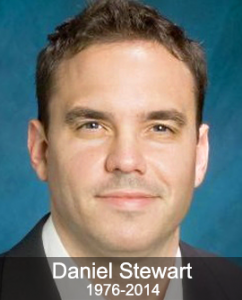 Six months ago (after taking only 9 pills), I found myself afflicted with post-finasteride syndrome, and since then my life has been fundamentally altered… But for your efforts providing hope, I probably wouldn’t be alive today.
Six months ago (after taking only 9 pills), I found myself afflicted with post-finasteride syndrome, and since then my life has been fundamentally altered… But for your efforts providing hope, I probably wouldn’t be alive today.
Our efforts notwithstanding, Daniel isn’t alive today. On April 12, 2014, at his home in Denton, TX, the 37-year-old Professor of Criminal Justice at the University of North Texas took his own life. It was a tragedy that annihilated any sense of normalcy about finasteride we retained at that point. Worse, such tragedies would soon become par for the course.
But back to 2017. Having collected ample records from the families of eight PFS suicide cases, all of whom were eager to try and prevent future PFS suicides, we stepped into the regulatory ring. That, by filing an FDA Citizen Petition: 120 pages of scientific and medical evidence that finasteride poses a threat to public health and should be taken off the market.
Now fast forward to 2020. Still no response from the FDA to our petition, yet a slew of new evidence had emerged to support our plea. So in December we filed two supplements to the petition. Supplement 1 contained scientific research, epidemiological data and other pertinent information, including animal studies, clinical studies and label updates mandated in Europe by the European Medicines Agency, about anxiety and suicidal ideation, that the FDA has not implemented in the US. Supplement 2 referred exclusively to the Reuters report headlined Court let Merck hide secrets about a popular drug’s risks. Published in September 2019 after a yearlong investigation, the story uncovered testimony in the US Propecia litigation by former Merck executives suggesting that the pharmaceutical giant downplayed the drug’s side effects during clinical trials. Specifically, Merck found evidence of persistent side effects in their original trials but failed to disclose such in their product label. Compounding this lack of transparency, the judge in the litigation, Brian Cogan, inexplicably allowed Merck and plaintiffs’ lawyers to keep information submitted in court under wraps.
To date, the FDA has not responded to our petition.
LITIGATION
Upon publishing its investigative report on Merck downplaying persistent side effects in the clinical trials, Reuters filed a motion in federal court to unseal documents from the US Propecia litigation. Sixteen months later, Judge Peggy Kuo approved that motion, clearing the way to make public nearly all of the Merck documents in the litigation. In her decision, Kuo noted that Merck’s arguments for keeping the lid on those documents “are so weak that they would not overcome even a low presumption of access under the common law.”
MEDIA AWARENESS
On Feb. 3, 10 days after Judge Kuo’s unsealing, Reuters, now armed with 197 pages of public documents, reported:
Merck & Co. and US regulators knew about reports of suicidal behavior in men taking… Propecia when they decided not to warn consumers of those potential risks in a 2011 [label] update… Since the 2011 decision on the warning, the FDA has received more than 700 reports of suicide and suicidal thoughts among people taking…the drug. Those included at least 100 deaths. Before that, in the first 14 years the drug was on the market, the agency received 34 such reports, including 10 deaths.
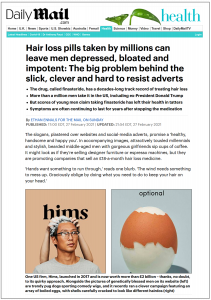 Later that month, the UK’s Daily Mail ran a feature headlined, Hair loss pills taken by millions can leave men depressed, bloated and impotent. The paper noted that it “has heard from scores of men who claim that taking finasteride has left their health in tatters. Impotence, depression, flaky, puffy skin, insomnia and drastic weight loss are among just some of the problems suffered by young men—with symptoms often lasting for years after stopping the medication.” Among the experts quoted was Philip Roberts, who said, “On average, we are contacted by 45 new patients every month from across the globe. That’s up 462 percent since 2018.”
Later that month, the UK’s Daily Mail ran a feature headlined, Hair loss pills taken by millions can leave men depressed, bloated and impotent. The paper noted that it “has heard from scores of men who claim that taking finasteride has left their health in tatters. Impotence, depression, flaky, puffy skin, insomnia and drastic weight loss are among just some of the problems suffered by young men—with symptoms often lasting for years after stopping the medication.” Among the experts quoted was Philip Roberts, who said, “On average, we are contacted by 45 new patients every month from across the globe. That’s up 462 percent since 2018.”
Three months earlier, the first of the HMS pharmacovigilance studies was widely cited in the media. In November, US News & World Report carried a story asking, Could Propecia Up Young Men’s Suicide Risk? It read, in part:
Information from the World Health Organization indicates that over the past 10 years, reports of suicidal ideation among young men using the drug have increased, rising significantly after 2012… Trinh’s team used data from VigiBase, which gathers information from 153 countries on all adverse drug reactions and contains more than 20 million safety reports. The researchers found 356 reports of suicidality and nearly 3,000 reports of other psychological problems among people taking finasteride.
Trinh’s research also made headlines in Russia, where, prior to 2020, PFS news of any kind was virtually non-existent. On Nov. 12, the popular portal С точки зрения науки (Naked Science) ran a report headlined Подтверждена связь между приемом популярного средства от облысения и возникновением суицидальных мыслей, which translates as, The Link Between a Popular Hair-loss Medication and the Occurrence of Suicidal Thoughts Has Been Confirmed.
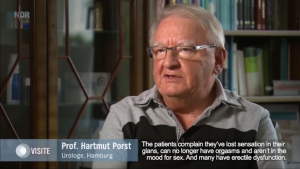 Abroad as well, German TV network NDR debuted a PFS documentary in January titled The Side Effects of Finasteride Are Underestimated, in which Hartmut Porst, MD, founder of the European Institute for Sexual Health, said:
Abroad as well, German TV network NDR debuted a PFS documentary in January titled The Side Effects of Finasteride Are Underestimated, in which Hartmut Porst, MD, founder of the European Institute for Sexual Health, said:
As of 2018, 15,000 cases of finasteride side effects were reported to the WHO—which is a huge number to begin with. And the interesting thing is that the average age of this group was 32 to 34 years old… This drug for young men must be taken off the market.
Six months later, another German TV network, WDR, featured a hair-loss report on its Tricks of the Beauty Industry magazine show. In it, Julia Maerker-Stroemer, MD, said of finasteride:
There are feared side effects that include sexual dysfunction in men, some of which can be very serious. And it must be mentioned that there are cases in which these functions are irreversibly impaired, which means there is no recovery after discontinuation of the use.
(For a complete listing of PFS press coverage, please visit our PFS Media Awareness page.)
DIGITAL GROWTH
It’s no secret that we’re always looking to supplement our website with content that provides added resources and support for the PFS community while furthering public awareness of the condition. This past year was particularly busy.
PFS Quilt
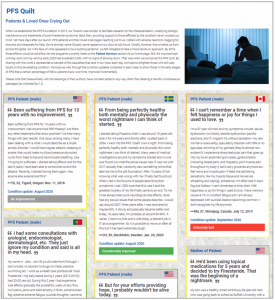 In November we launched the PFS Quilt (in the News tab of our menu), a representative sample of the frequently furious and distressed emails that land in our inbox daily from patients, their loved ones and health care providers across the globe. One patient from Stuttgart, Germany, for example, told us:
In November we launched the PFS Quilt (in the News tab of our menu), a representative sample of the frequently furious and distressed emails that land in our inbox daily from patients, their loved ones and health care providers across the globe. One patient from Stuttgart, Germany, for example, told us:
I am 35 years old and have this Syndrome since I have been 24 years old. My Life was smashed and destroyed after I started with Finasteride. I can’t stop thinking about this one moment I decided to go to this special Doctor who treats hairloss. I was 24 years young and I had full beautiful hair. This Doctor made some tests and scared the shit out of me by prognosing a full bald me in a few years. I trusted him and took the pills he gave me. Safe pills he said. No side-effects. Soon after I started the pills my life made a u-turn. I was finishing university and had already found a new job in a new city. That’s when I start to enter hell. I lost my mind and had the most disgusting mental health issues. I had to go to the hospital and started with suicide thoughts…I am living now for seven years with my parents in their tiny apartment and do not know what to do.
Through the publication of such content, inspired by the AIDS Memorial Quilt of 1987, we hope to enlighten those who still cast doubt on the existence of PFS. We hope as well, through the condition updates contained in each case, to show those in the early stages of this horrific affliction that a certain percentage of fellow patients have, over time, improved incrementally.
Hindi Edition
On January 20, at the moment that Kamala Harris—America’s first vice president of South Asian descent—was inaugurated, we launched a Hindi edition of our website. It arrived just nine months after our Russian edition, 15 months after our Chinese edition and 27 months after our Spanish edition. This aggressive stepping up of global awareness efforts got under way in September 2018, with the relaunch of our flagship English edition. Since then, average monthly traffic to our site has risen 225 percent, with 41,500 new Spanish-speaking users, 12,700 new Chinese-speaking users, and 7,600 new Russian-speaking users. Once again, this latest foreign-language edition was made possible by a member of the PFS community who’s dedicated to warning fellow citizens of finasteride’s many potential dangers. That would be Ranjith Shanghvi, a 35-year-old technical editor from Kanpur, India, who has been suffering from PFS since 2017.
Propecia Litigation Library
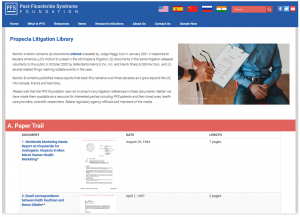 Thanks to Judge Kuo’s ruling, we were able to publish nearly all the documents from the US Propecia litigation that had been sealed since 2018, when a settlement was reached.
Thanks to Judge Kuo’s ruling, we were able to publish nearly all the documents from the US Propecia litigation that had been sealed since 2018, when a settlement was reached.
Launched in June, our Propecia Litigation Library (in the News tab) is segmented into two parts. Part A (Paper Trail), contains 479 pages of such documents, along with 125 pages of related content.
Part B (Media Pursuit) contains 18 media reports that track the Propecia narrative from FDA approval of the drug in 1997 to revelations from the unsealed documents to a recent suicide case in the UK in which the victim’s father detailed at a public inquest how his son had grown increasingly despondent after developing PFS.
In 1997, for example, The New York Times noted, “Critics…complain that no long-term studies have been conducted on” Propecia. Twenty-four years later, Reuters opened an exclusive report with this sentence:
Newly unsealed court documents and other records show that Merck & Co. and US regulators knew about reports of suicidal behavior in men taking the company’s anti-baldness treatment Propecia when they decided not to warn consumers of those potential risks in a 2011 update of the popular drug’s label.
And less than three months ago, the Daily Mail, in a story headlined Man, 24, Who Said He Was Depressed After Taking Hair Loss Tablet Finasteride Over Five Years Killed Himself by Jumping off Bridge, Inquest Hears, wrote:
The inquest heard Jack had researched post-finasteride syndrome online which gave a very bleak outlook and led him to believe he had ruined his life. He died from multiple injuries in the fall from 24 metres from the road bridge.
PFS Brain Bank
In July, we launched a page (in the Resources tab) about the PFS Brain Bank. Since 2013, we have maintained this service at Texas Tech University Science Center El Paso. Its purpose is to collect brain and spinal-cord tissue for distribution to researchers undertaking studies of psychiatric illnesses stemming from PFS. Now, patients and/or their family members who are interested in learning more about the brain bank can contact TTUHSC directly.
Traffic milestones
As global usage of our website continues expanding, we continue to achieve new milestones. Among this year’s are:
- Historic users: In January we surpassed 500,000 unique visitors since the site was launched in July 2012.
- Page views: In July we surpassed 1.5 million page views since the site was launched.
- Monthly visits: In November we hit a record high of 17,242 unique monthly visitors.
- Daily visits: On Dec. 11 we hit a record high of 3,676 unique daily visitors.
- Monthly visits China: In July we hit a record high of 2,667 unique monthly visitors to the Chinese edition of our site, up 214% over July 2020.
MEDICAL AWARENESS
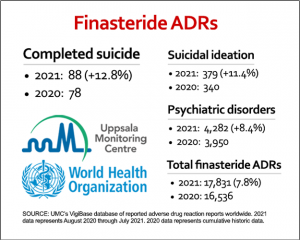 We continue to monitor and publish adverse drug reaction (ADR) data for finasteride housed in the World Health Organization’s VigiBase database so that health care professionals, the general public and members of the media are aware of global trends. Once again, many of the key indicators have risen year over year, with completed suicides again leading the pack percentage-wise at 12.8%, followed by suicidal ideation at 11.4%, psychiatric disorders at 8.4%, depression at 5.8% and suicide attempts at 5.4%. The absolute number of 1,295 new ADRs during this period translates into 3.5 likely cases of PFS each day, while the 10 new suicides equate to about one every six weeks.
We continue to monitor and publish adverse drug reaction (ADR) data for finasteride housed in the World Health Organization’s VigiBase database so that health care professionals, the general public and members of the media are aware of global trends. Once again, many of the key indicators have risen year over year, with completed suicides again leading the pack percentage-wise at 12.8%, followed by suicidal ideation at 11.4%, psychiatric disorders at 8.4%, depression at 5.8% and suicide attempts at 5.4%. The absolute number of 1,295 new ADRs during this period translates into 3.5 likely cases of PFS each day, while the 10 new suicides equate to about one every six weeks.
Clinicians, pharmacologists and researchers worldwide, increasingly via social media, continue to voice their concerns about finasteride therapy, particularly for young men. Year over year, the number of such professionals aggregated on our Doctors & Researchers Speaking Out page rose 48%, from 50 to 74. Among the new entrants is Jessica Yih, MD, a urologist at Ohio State University’s Wexner Medical Center, who in November tweeted, “Post finasteride syndrome is so real! Hundreds of patients coming to #sandiegosexualmedicine with this. Often have low t. Make sure to check dht also!” A month later, Bhavik Shah, MD, of Advanced Urology in Decatur, GA, tweeted, “Finasteride is phasing out of my practice.” And a month after that, Jared Wallen, MD, of YOU & WEE Urologic Surgery & Wellness in Sarasota, FL, tweeted, “Finasteride USERS BEWARE!!! I stop just about every patient that comes to me on this medication.”
 Finally, Keshav Narain, MD, of the South Bay Retina Ophthalmology Clinic, in San Jose, CA, went so far as to post an open letter about finasteride on his blog three months ago. It reads, in part:
Finally, Keshav Narain, MD, of the South Bay Retina Ophthalmology Clinic, in San Jose, CA, went so far as to post an open letter about finasteride on his blog three months ago. It reads, in part:
Patients and doctors remain largely unaware of the long-term consequences of this drug on the nervous system and mental health… [W]e encountered a surprising association between finasteride use and presence of optic neuropathy or retinopathy. Finasteride-associated ocular toxicity has not been previously documented in the medical literature. For ophthalmologists, this means mild alterations in nerve and retinal function are likely to be attributed to more familiar and common conditions like glaucoma or retinopathy… We have made it a point now to ask every patient about finasteride use. We hope that you will do the same.
PATIENT SERVICES
The number of doctors, psychologists and pharmacologists volunteering to counsel PFS patients as members of our Medical Professionals team rose 17% this year, from 100 to 117. They join us from 26 nations across 17 specialties, and many continue to approach us unsolicited. Case in point, Rob Kominiarek, DO, a neuroendocrinologist in Miamisburg, OH, wrote, “Over the weekend we had two new patients contact the office after taking Propecia only short-term and developing erectile dysfunction. I see approximately two new paients each month with this same complaint.”
 Also Wilson Della Paschoa, MD, in Goiánia, Brazil, who wrote, “I’m following Dr. Abdulmaged Traish’s PFS research, and I’ve treated hundreds of patients suffering from PFS. The hard part is trying to educate other doctors about it. But I will be your andrology professor in Brazil if and when you need.” From Jim Dhrymes, MD, in New York to Vijayant Govinda Gupta, MD, in New Delhi to Gervais Harry, MD, in Toronto to Ángel Cunill Castro, MD, in Madrid, we thank them one and all for their ongoing efforts to help PFS patients remain stable and hopeful.
Also Wilson Della Paschoa, MD, in Goiánia, Brazil, who wrote, “I’m following Dr. Abdulmaged Traish’s PFS research, and I’ve treated hundreds of patients suffering from PFS. The hard part is trying to educate other doctors about it. But I will be your andrology professor in Brazil if and when you need.” From Jim Dhrymes, MD, in New York to Vijayant Govinda Gupta, MD, in New Delhi to Gervais Harry, MD, in Toronto to Ángel Cunill Castro, MD, in Madrid, we thank them one and all for their ongoing efforts to help PFS patients remain stable and hopeful.
Meanwhile, our Patient Support program, designed to connect PFS patients across the globe for moral support and sharing potentially helpful coping strategies, continues to be one of our most popular services. Since its launch in 2016, thousands of afflicted men and their loved ones—who would otherwise have virtually no way of finding one another—are today in regular contact.
 As we embark on year 10 of our mission to facilitate PFS research, generate PFS awareness, provide support to PFS patients and prompt regulatory action on the condition, I ask you to continue giving generously to the foundation so we may continue this urgent work.
As we embark on year 10 of our mission to facilitate PFS research, generate PFS awareness, provide support to PFS patients and prompt regulatory action on the condition, I ask you to continue giving generously to the foundation so we may continue this urgent work.
In the meantime, as directed on our Report Your Side Effects page, anyone living in the US who suffers from PFS should report his (or her) symptoms to the FDA. Anyone living outside the US who suffers from the condition should report his symptoms to the FDA, as well as to his national drug-regulatory agency.
Finally, if you or a loved one are suffering from PFS and feeling depressed or unstable, please don’t hesitate to contact us via our Patient Support hotline: social@pfsfoundation.org
Sincerely,
John Santmann, MD
CEO
Related News
2020 PFS Foundation Annual Address
2019 PFS Foundation Annual Address
2018 PFS Foundation Annual Address
2017 PFS Foundation Annual Address
2016 PFS Foundation Annual Address
2015 PFS Foundation Annual Address
2014 PFS Foundation Annual Address
2013 PFS Foundation Annual Address
